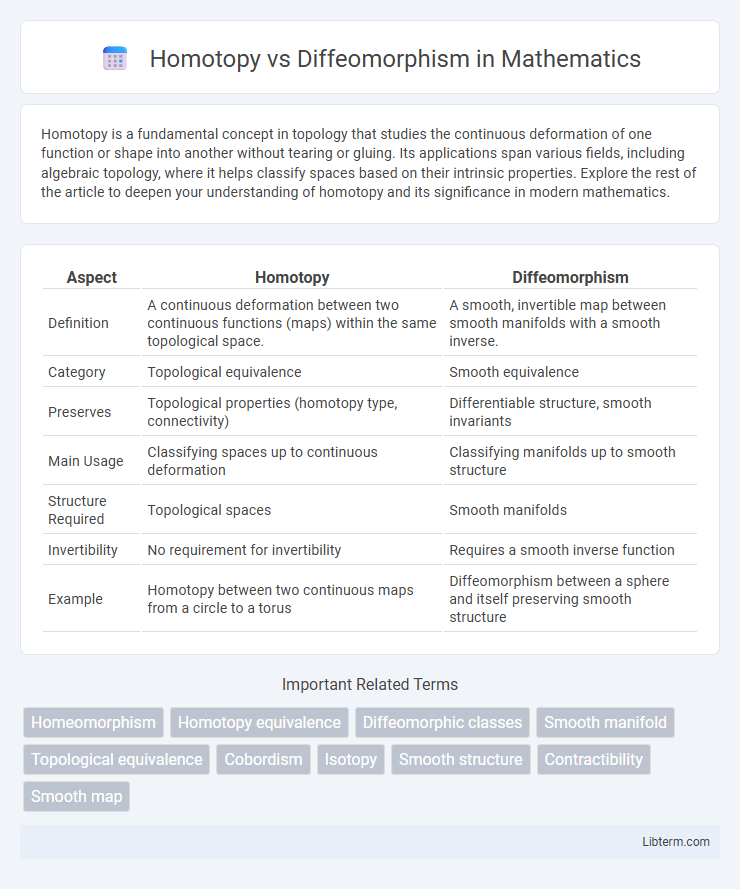Homotopy is a fundamental concept in topology that studies the continuous deformation of one function or shape into another without tearing or gluing. Its applications span various fields, including algebraic topology, where it helps classify spaces based on their intrinsic properties. Explore the rest of the article to deepen your understanding of homotopy and its significance in modern mathematics.
Table of Comparison
| Aspect | Homotopy | Diffeomorphism |
|---|---|---|
| Definition | A continuous deformation between two continuous functions (maps) within the same topological space. | A smooth, invertible map between smooth manifolds with a smooth inverse. |
| Category | Topological equivalence | Smooth equivalence |
| Preserves | Topological properties (homotopy type, connectivity) | Differentiable structure, smooth invariants |
| Main Usage | Classifying spaces up to continuous deformation | Classifying manifolds up to smooth structure |
| Structure Required | Topological spaces | Smooth manifolds |
| Invertibility | No requirement for invertibility | Requires a smooth inverse function |
| Example | Homotopy between two continuous maps from a circle to a torus | Diffeomorphism between a sphere and itself preserving smooth structure |
Introduction to Homotopy and Diffeomorphism
Homotopy studies continuous deformations between two continuous functions, emphasizing the concept of topological equivalence without requiring smooth structures, making it fundamental in algebraic topology. Diffeomorphism involves a smooth, bijective map with a smooth inverse between differentiable manifolds, preserving the differential structure and enabling comparison of geometric properties. Understanding homotopy versus diffeomorphism highlights their roles in classifying spaces: homotopy focuses on topological equivalence classes, while diffeomorphism classifies manifolds up to smooth isomorphism.
Fundamental Concepts in Topology
Homotopy and diffeomorphism represent core concepts in topology, where homotopy classifies spaces based on continuous deformations without tearing or gluing, focusing on preserving topological properties such as connectedness and holes. Diffeomorphism refers to a smooth, invertible map between manifolds that preserves differentiable structure, establishing an equivalence stronger than homotopy by requiring smooth and continuous transformations with smooth inverses. Understanding the distinction between homotopy equivalence and diffeomorphic equivalence is crucial for classifying manifolds in algebraic and differential topology, reflecting the difference between topological and geometric structure preservation.
Formal Definition of Homotopy
Homotopy is a continuous deformation between two continuous functions from one topological space to another, defined formally as a continuous map \( H: X \times [0,1] \to Y \) such that \( H(x,0) = f(x) \) and \( H(x,1) = g(x) \) for all \( x \in X \). This concept contrasts with diffeomorphism, which requires a smooth, invertible map with a smooth inverse between differentiable manifolds. The core distinction lies in homotopy focusing on flexible continuous transformations preserving topological properties, while diffeomorphism demands rigid, smooth equivalence preserving differentiable structure.
Understanding Diffeomorphism
Diffeomorphism refers to a smooth, invertible map between differentiable manifolds that preserves the differentiable structure, ensuring both the map and its inverse are infinitely differentiable. Unlike homotopy, which focuses on continuous deformation and equivalence up to continuous transformation, diffeomorphism requires a stricter condition maintaining smoothness and geometric structure. Understanding diffeomorphism is crucial in differential topology, as it classifies manifolds up to smooth equivalence, distinguishing them by their differentiable properties rather than just topological ones.
Key Differences Between Homotopy and Diffeomorphism
Homotopy and diffeomorphism are distinct concepts in topology and differential geometry, respectively. Homotopy focuses on continuous deformations between maps, preserving topological properties without requiring smoothness or invertibility, while diffeomorphism demands a smooth, bijective map with a smooth inverse, preserving differentiable structures. Key differences include homotopy's emphasis on topological equivalence versus diffeomorphism's strict smooth equivalence, and diffeomorphisms inducing isomorphisms between tangent spaces, unlike homotopies which do not necessarily preserve such geometric structures.
Examples Illustrating Homotopy
Homotopy involves continuously deforming one function or shape into another within a topological space, such as deforming a circle into an ellipse or shrinking a loop on a sphere to a point. A classic example of homotopy is the continuous transformation of a coffee cup into a donut shape (torus), illustrating that these shapes are homotopy equivalent despite differing in geometry. Unlike diffeomorphism, which requires smooth and invertible maps preserving geometric structures, homotopy focuses on the broader notion of topological equivalence through continuous deformation.
Real-World Instances of Diffeomorphism
Diffeomorphisms play a crucial role in real-world applications such as robotics, where smooth and invertible transformations map robot configurations for precise motion control. In computer graphics, diffeomorphic algorithms enable seamless image morphing by preserving topological structures during complex shape deformations. Furthermore, in medical imaging, diffeomorphisms facilitate accurate brain image registration, allowing for reliable comparisons across patients by maintaining differentiable transformations between anatomical structures.
Importance in Mathematics and Physics
Homotopy and diffeomorphism are crucial concepts for classifying and understanding topological and smooth structures in mathematics and physics. Homotopy captures continuous deformations between functions or spaces, revealing fundamental topological invariants critical in fields such as algebraic topology and quantum field theory. Diffeomorphism provides a framework for distinguishing smooth manifolds up to smooth equivalence, underpinning the study of differential geometry and general relativity by describing the smooth structure of spacetime.
Applications in Geometry and Topology
Homotopy and diffeomorphism serve distinct roles in geometry and topology, with homotopy classifying continuous deformations between maps, crucial for understanding topological invariants such as fundamental groups and homology. Diffeomorphisms preserve smooth structure, enabling the classification of manifolds up to smooth equivalence, essential in differential topology and geometric structures on manifolds. Applications include the study of fiber bundles, characteristic classes, and smooth manifold invariants like the Milnor exotic spheres distinguished by diffeomorphism classes rather than homotopy type.
Conclusion: When to Use Homotopy vs Diffeomorphism
Homotopy is best applied in topology to study continuous deformations between spaces, capturing their fundamental connectivity without preserving geometric structure. Diffeomorphism is essential in differential geometry when smooth, invertible mappings preserving differentiable structures and finer geometric properties are required. Choose homotopy for classification up to continuous deformation and diffeomorphism when precise smooth equivalence of manifolds is necessary.
Homotopy Infographic

 libterm.com
libterm.com